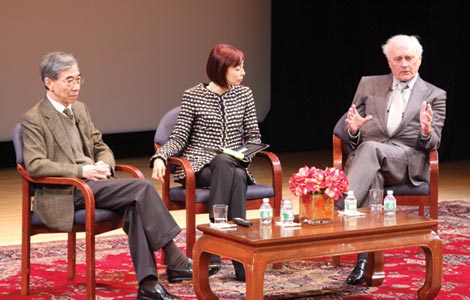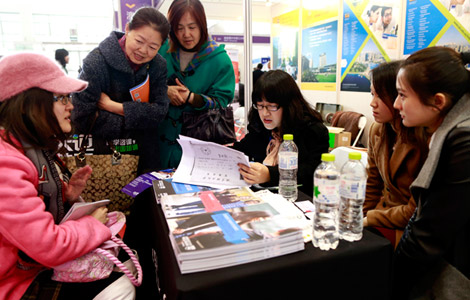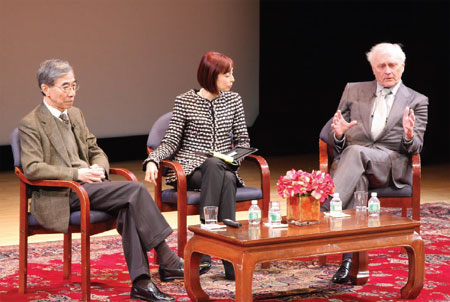Nurturing the art scholars of tomorrow
Updated: 2014-03-17 11:13
By Jack Freifelder in New York (China Daily USA)
|
||||||||
Important impediments in the effort to cultivate interest in Chinese art are the issues of accessibility and familiarity, according to a panel of experts assembled by the Asia Society on Sunday in New York.
James C. Y. Watt, professor of Chinese Culture at the Chinese University of Hong Kong, said that professors face a challenge in their attempts to motivate young people to even consider a profession in the field of fine arts.
"Like many people in my generation, I didn't start out wanting to be an art historian," Watt said Sunday. "I was actually a physicist as an undergraduate at Oxford University and I thought, 'Well, [art] is more fun than physics.'"
"But the most basic aspect is that it's become extremely difficult to get good young people to enter and pursue the profession," Watt added. "That causes a big problem."
Chinese art experts Watt and Marc F. Wilson joined moderator Melissa Chiu, the Asia Society's museum director and senior vice-president of Global Arts and Cultural Programs, for a panel discussion at the Asia Society headquarters at the event titled Chinese Museums in the 21st Century: A Discussion on the Field of Chinese Art.
Members of the Asia Society and art enthusiasts discussed about how the perception of Chinese art has changed over the past two decades.
They touched on a variety of topics, including the perception and study of Chinese art in an academic setting, the value of the Chinese aesthetic and the important role collectors play in an ever-changing global art environment.
Wilson - former director of the Nelson-Atkins Museum of Art in Kansas City, Missouri, a space renowned for its extensive collection of Asian art - said that the "central issue" for any piece of artwork is its ability to convey a message.
"The central issue for a great work of art is whether it has the power to communicate and facilitate a meaningful experience," Wilson said. "The greatest works of art are accessible though, so a Chinese student does not have to be the only one who can study Chinese art."
The event was in conjunction with Asia Week, which runs from March 14-22.
Asia Week New York 2014 is a nine-day celebration for Asian art throughout New York City, with exhibitions, auctions and special events presented by a host of participants, including 19 museums and cultural institutions.
Watt, who is also a Curator Emeritus of Asian Art at the Metropolitan Museum of Art, said that people considering jobs as art historians are losing out on the "progressive learning experience" that the art engagement process entails.
"Many people consider pursuing professions as academic art historians, but that's a secondary profession to people who are custodians of works of art," Watt said.
"I am a bit skeptical of any kind of museum training courses because it's not possible to learn about museum work in a classroom. It's like talking about aeronautics without being near an airplane," he said.
Wilson, who retired as the fourth director of the Nelson-Atkins Museum of Art in June 2010, said an essential part of understanding any artwork is having a deep knowledge of the circumstances of its creation.
"When you're willing to work to understand these objects, which is part of the cultivation process for the individual, art becomes something inspiring," he said.
jackfreifelder@chinadailyusa.com
|
From left: James C. Y. Watt, professor of Chinese culture at the Chinese University of Hong Kong; Melissa Chiu, Asia Society's museum director and senior vice-president of Global Arts and Cultural Programs; and Marc F. Wilson, former director of the Nelson-Atkins Museum of Art in Kansas City, Missouri, take part in a panel discussion on Sunday at the Asia Society headquarters in New York. Jack Freifelder / China Daily |
(China Daily USA 03/17/2014 page2)

 Nurturing the art scholars of tomorrow
Nurturing the art scholars of tomorrow
 Chinese Americans will be awarded Ellis Island medals
Chinese Americans will be awarded Ellis Island medals
 Crimeans start celebrating pending referendum outcome
Crimeans start celebrating pending referendum outcome
 European universities growing in popularity among students
European universities growing in popularity among students
 Muslims in Malaysia pray for missing plane
Muslims in Malaysia pray for missing plane
 Ukraine's Crimea kicks off referendum
Ukraine's Crimea kicks off referendum
 Travel-tourism forum advises US to 'loosen' visa requirements
Travel-tourism forum advises US to 'loosen' visa requirements
 Nose gear on plane collapses at Philly airport
Nose gear on plane collapses at Philly airport
Most Viewed
Editor's Picks

|

|

|

|

|

|
Today's Top News
Jewish holiday of Purim celebrated in US
US not to recognize Crimean referendum
Missing jet pilots' motive probed
Alibaba's IPO will be in NYC
WeChat to take on WhatsApp
China tourism boosted at NBA game
Alibaba opts for IPO in US
Stronger cop presence urged
US Weekly

|

|







